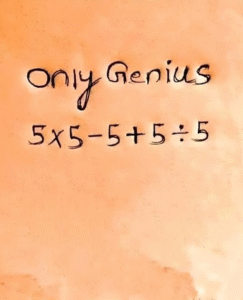Only Geniuses Can Solve This Math Puzzle in 10 Seconds
It starts off looking innocent enough—a basic math puzzle, just a few numbers and symbols on a screen or chalkboard. But before you can even reach for a calculator, the clock is ticking. “Only geniuses can solve this in 10 seconds,” it warns, challenging your pride and your logic at the same time. And suddenly, it’s not just a puzzle—it’s a personal test of intelligence.
The puzzle reads:
8 + 3 × (2 + 1) – 4 ÷ 2 = ?
At first glance, it seems simple. You might be tempted to just go from left to right, solving each part step-by-step. But if you do that, you’ll almost certainly get the wrong answer. That’s the trap. The puzzle isn’t hard because the math is complex—it’s hard because the rules must be remembered and applied instantly.
The key lies in understanding the order of operations, often remembered by the acronym PEMDAS (Parentheses, Exponents, Multiplication and Division, Addition and Subtraction). If you follow that sequence carefully, the answer reveals itself clearly—but only if your brain resists the urge to rush.
Let’s break it down properly:
8 + 3 × (2 + 1) – 4 ÷ 2
Step 1: Solve inside the parentheses
(2 + 1) = 3
Now the equation becomes:
8 + 3 × 3 – 4 ÷ 2
Step 2: Handle multiplication and division (from left to right)
3 × 3 = 9
4 ÷ 2 = 2
Now the equation becomes:
8 + 9 – 2
Step 3: Addition and subtraction (from left to right)
8 + 9 = 17
17 – 2 = 15
So, the correct answer is 15.
Simple, right? But most people don’t get that answer on their first try, especially under pressure. In fact, studies show that when presented with this type of puzzle and given only 10 seconds, many people answer 5, 13, or even 23—results that come from skipping or misapplying the order of operations.
That’s what makes puzzles like this so fascinating. They’re not testing your knowledge of advanced calculus or complex equations—they’re testing your clarity of thought under pressure. Can you remember a basic rule, apply it quickly, and ignore the urge to guess?
Social media has taken puzzles like this viral, often labeling them with clickbait titles like “Only Geniuses Can Solve This” or “99% Will Fail.” While that’s a stretch, the psychological game behind the challenge is real. It plays on speed, ego, and the very human desire to prove ourselves—especially when others are watching.
But the truth is, you don’t have to be a genius to solve this puzzle in 10 seconds. You just need focus, calm, and a good memory of the rules you likely learned in elementary school.
So next time you see one of these so-called “genius puzzles,” don’t rush. Take a breath. Remember PEMDAS.
And then impress everyone by solving it in 5 seconds flat.
